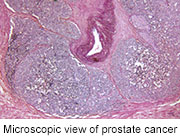
WEDNESDAY, March 12, 2014 (HealthDay News) — A newer form of radiation therapy for prostate cancer is faster and less expensive, but it can cause more urinary complications, a new study suggests.
The newer therapy delivers a greater dose of radiation per treatment than standard radiation therapy, which means prostate cancer patients can complete an entire course of treatment in one to two weeks instead of seven to nine weeks.
There have, however, been few studies comparing the costs and side effects of the two methods.
In this study, Yale University researchers looked at data from more than 4,000 Medicare patients aged 66 and older who received either the newer radiation therapy or the standard radiation therapy as primary treatment for prostate cancer.
The average per-patient cost was about $13,600 for the new therapy and $21,000 for the standard therapy. Two years after the start of treatment, patients who received the newer therapy had more side effects — such as irritation of the urethra, urinary incontinence and urinary obstruction — than those who received standard radiation therapy.
But even when the costs of treating those complications were included, the overall cost of the newer therapy was still lower than the standard therapy, according to the study, which was published March 10 in the Journal of Clinical Oncology.
“While these data are by no means definitive, our findings emphasize the need to carefully assess the impact of new cancer treatment technologies in actual practice,” senior study author Dr. Cary Gross, a professor of internal medicine at the Yale School of Medicine, said in a university news release.
More information
The U.S. National Cancer Institute has more about prostate cancer treatment.
Copyright © 2025 HealthDay. All rights reserved.

